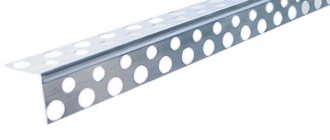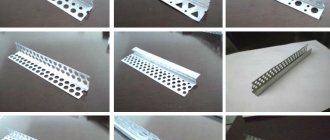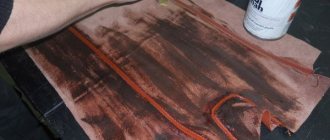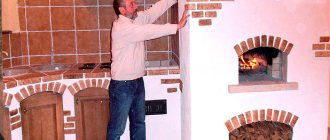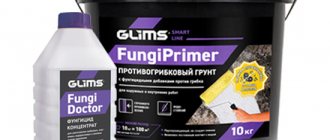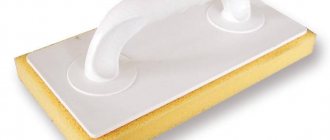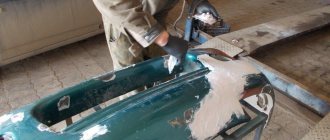How does he work
Briefly, its operating principle is as follows: using a bent long metal or plastic plate, which is installed on a corner, creating a flat surface there, a base is formed, which will then be processed with a solution. The holes are needed so that the mixture can pass through them freely (in both directions), that is, so that the deficiencies are filled and the excess comes out; in addition, applying holes to the product (perforation) reduces its weight, thereby reducing the load on the solution and grip increases.
Grouting corners and leveling wall surfaces
After the plaster mixture has hardened in the places where the corner pads are placed, plastering work is carried out in stages:
- using a trowel placed at an angle of 30-40°, the base is grouted;
- then a solution is applied near the profiles, which is smoothed using a rule to eliminate excess mixture;
- smooth the surface with a trowel;
- the bases are leveled, while the corners should not protrude outward;
- Polymerization is carried out on the dried wall panel and the final grouting begins;
- internal corners are rubbed using a grater with a sponge surface.
Is it possible to make a corner without a corner?
By and large, yes. But you need to understand that the corner overlay is used not only to form a joint between wall surfaces, but also to strengthen it and make it resistant to mechanical damage. Without an overlay, your corner will crack from the slightest shock, and if we are talking about an apartment, you will have to plaster it again in about half a year. Finishing without overlays is used when there is absolutely no threat of impact loads, which is extremely rare.
How to choose
They are mainly made of plastic and metal. Let's consider the characteristics and purpose of each type of product.
Metal
Metals are sensitive to alkaline and acidic environments, so they are used mainly when latex, gypsum or acrylic are used as finishing materials.
- Aluminum. Linings made from this material are the cheapest and most common. They have good corrosion resistance; due to their lightness, they stick well to the wall and do not move during operation. But, since aluminum is a very soft metal, its impact resistance and resistance to mechanical damage is minimal. This can lead to the fact that from a weak blow, not only the plaster will crack, but also the corner will bend, which means that it will no longer be necessary to carry out cosmetic repairs, but a thorough one, with the replacement of the entire lining. This is why aluminum angles are not used in areas where there is an increased risk of impact loading on walls, such as factories, loading bays or shops. Where workers frequently hit corners, steel should be used.
- Galvanized steel is not as common because it is much more expensive than aluminum, but it has higher strength characteristics. Thanks to this, steel corners withstand impacts very well and do not bend even from a very large-scale collision, however, this metal is heavier than aluminum, so the technology for installing steel corners is somewhat different. It must be taken into account that due to its mass, the lining will peel off or slide down. In addition, it is important not to damage the galvanization, because it protects the steel from rusting. The product should be trimmed with special metal scissors, and in no case with a grinder, so that after a few years the repair does not have to be done again.
Shapes of metal overlays
The appearance of the product can be completely different, depending on the purpose of the repair, but basically it is just a strip of steel or aluminum, bent at a right angle, in which many small holes are drilled. The thickness of the lining is small - a little more than half a millimeter. Such simple corners are used for dry plaster, and if moisture is present in the process, an additional metal mesh is used, which increases adhesion to the wall due to the fact that more mortar is in contact with the product. Rounded corners are very rarely made from metal, because, as a rule, it is required that the radius of curvature can be changed, and in the case of such durable materials this is simply impossible.
Plastic products
In terms of its strength characteristics, plastic is inferior to metals, and even aluminum, because if the latter simply bends from an impact without causing further destruction of the plaster, then the plastic immediately cracks. In order to achieve at least some strength of the product, the corner has to be made thick, and the plaster, accordingly, must be applied in a thin layer. However, it has an advantage in rooms with high humidity - it is not at all afraid of corrosion, so it is usually used in such cases.
In addition, it is much easier to make a curved corner from plastic (of course, from the point of view of geometry, it will no longer be a corner, but an arc, but they still call it that) with an arbitrary variable bending radius. After all, plastic is very malleable, and the aluminum plate is difficult to bend due to its large length. And products with an adjustable angle are generally a typical phenomenon for plastic, since it bends very easily without violating the integrity of the structure.
Chemical inertness of plastic corners
Since plastic reacts very poorly with other substances, it is advantageous to use it in areas where reagents are used or, for example, in chemical production. Since the air in these places contains a certain concentration of alkalis and acids, they are also absorbed into the walls, negatively affecting the materials. As a rule, metals under plaster become unusable after just a few years.
Purpose of perforated corners
What are perforation angles?
A perforated corner is a special device that acts as a frame for applying putty. A solid base allows you to achieve ideal geometry in both horizontal and vertical planes.
Among other things, a perforated corner for wall corners performs a protective and strengthening function. Fixed to the wall under wallpaper or another type of covering, this detail prevents premature destruction of the wall due to damage when carrying furniture, being hit by a heavy object, or frequent contact with the body of household members.
Material of manufacture
Currently, manufacturers produce many modifications of corners for wall putty. The purpose of the perforated corners for putty is determined by the base material and the shape of the product. Various materials are used as raw materials for their manufacture, each of which has a unique set of characteristics.
What material corner is best suited for a wooden wall?
The tree itself is already quite strong, especially if we are talking about timber, and it does not need additional reinforcement, so you can save on material here. However, plastic should not be used unless the corner is combined with a built-in metal mesh. The fact is that wood does not hold plaster well, and therefore, when finishing wooden houses, they use mesh of very large areas, ideally covering the entire wall - then the plaster will last longer. In general, in such cases, preference is usually given to either aluminum or combined plastic products.
How to use
Working with corner overlays consists of several stages, these are:
Preparing the wall
In order for the plaster to hold tightly, you should break off everything that is loose, so that a monolithic structure remains without any cracks or breaks. Do not skimp on the solution, because in the end the corner will only be stronger. Once you have knocked off all the loose pieces, you should move on to cleaning and priming. Remove dust from the surface with a special brush (but you can also use a simple rag), then prime the wall to ensure reliable adhesion to the solution.
Sometimes the wall joint is so damaged that a corner cannot even be attached to it, because there is simply nowhere to do it. In such cases, the surface is first plastered, preparing the base, and only then the corner overlay is installed on it.
And the last stage of preparation is the installation of beacons, which contribute to a more accurate location of the corner, with minimal deviations.
Product Installation
First you need to trim the overlay. Cut it with tin snips if it is steel or aluminum, or with a knife if it is plastic. Next, apply the solution to the wall and place the product on the corner. Press down lightly so that the solution begins to seep through the holes, and press down the mesh, if there is one, as firmly as possible. Check the correct installation using a level, and do not forget to check the beacons.
If the pad is made of heavy materials such as steel, then due to its large mass it will move down a little, so it would be a good idea to hold it for a while, especially if you are attaching it to the ceiling.
Using Fasteners
Holes in the corners are made not only to increase adhesion, lighten the structure and ensure the passage of the solution, but also in some cases to use screw fastenings. Plastic sleeves are driven into the hardened plaster, into which stainless screws are then screwed. This fastening allows you to significantly increase traction, but is used when it is not possible to use a mesh. And there is practically no point in using them at the same time, unless you are installing a corner in an elephant nursery.
When the solution under the pad dries
After the overlay firmly adheres to the wall, you should begin plastering the outer part of the corner and leveling it. The first step is to plaster everything next to the overlay to get the approximate thickness of the layer applied to the corner. When you have leveled the surface of the wall and the surface of the corner, start smoothing the plaster, but you should not get too fanatical - anyway, later, when it dries, it will need to be treated with sandpaper.
How to check your work
After completing each step, you should ensure that it was completed correctly. So, if in the middle of work you notice that you haven’t cleaned the wall well and there are broken pieces of plaster hanging on it, don’t be lazy, remove the corner and do it all over again, this will significantly increase the service life of the structure. If, for example, you notice that you pressed a corner onto the mortar too hard, so that it all flowed out through the perforation, remove it and put on new plaster, because the final result of your work depends most on such little things.
Profile device
This element is made from polyvinyl chloride in accordance with GOST 19111-2001. The profile material is resistant to shock and temperature influences, is not afraid of ultraviolet rays, is easy to install, and does not allow steam and water to pass through.
Structurally, the profile consists of the following elements:
The base is made of unplasticized (hard) PVC, on the back of which there is a self-adhesive sealing lamella made of polyurethane foam. It is this part that the profile is glued to the frame. It allows the element to fit closely to the window frame, and also plays the role of a kind of damper gasket, compensating for the thermal expansion of materials and wind load. By damping these vibrations, the lamella helps to preserve the inelastic layer of slope plaster.
- Protective cuff - inserts made of soft plasticized PVC. After finishing work is completed, this part of the product remains visible. It forms a neat and aesthetic joint between the slope and the window block and hides cracks that may appear on the corner seam over time.
- Tear strip equipped with a strip of glue. After removing the protective film, it is easy to attach polyethylene or a membrane to it, protecting the window from contamination by the plaster solution. After finishing the work, this strip is easily separated from the box.
- Reinforcing mesh made of alkali-resistant fiberglass, attached to an additional shelf.
The following video will tell you in detail about the design of a profile with a grid:
Self-adhesive plastic profiles with reinforcing mesh are used to form slopes on the outside of the building and inside the building.
Is it worth doing the corner plastering yourself, or is it better to entrust it to a professional?
On the Internet today you can find a huge number of articles and training videos on all types of construction and repair work. There are so many of them that it seems as if anyone could build a house and make repairs on it themselves, using only these manuals. But that's not true. The fact is that here you need not only knowledge of how to do it, but also skill, that is, experience. Because, for example, you can know how to hammer a nail, but not be able to do it in practice, the nail will be hammered crookedly, your finger will be damaged, etc. If you've ever glued wallpaper, you should know that even in such a seemingly simple task, you often have to redo everything several times, let alone plaster. A master who not only knows, but also knows how, will set you a high-quality angle in a minimum amount of time, while you can do other more important things.
Adviсe
The dimensions of the initial profile are determined in accordance with the existing panel. Correctly measured windows and doors and selection of the appropriate length of the corner profile for them make it possible to effectively save money when purchasing it.
1. It is recommended to choose materials for decorating an already installed window, since in practice it is much easier and more accurate to understand the condition of the openings during dismantling. This approach makes it possible to accurately select the type and characteristics of the profile for decoration.
2. When choosing between materials of different sizes, you should be guided by what this particular room where the opening is framed is intended for.
3.If this is a window in the kitchen or a door on the balcony, which requires increased wear resistance due to frequent manipulations, a practical option would be to install a wide corner profile. It is characterized by increased strength, which means it will correspond to the proper aesthetic appearance of the room for the maximum time.
4. It is not recommended to install elements of maximum width on narrow small windows; in this case, for decoration you should choose a thinner profile, for example − 15x15mm, it goes well with the elegant and light interior of the room.
